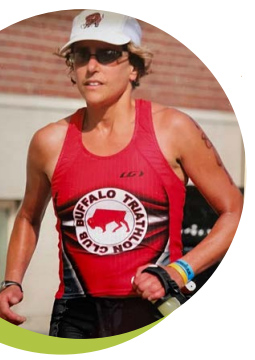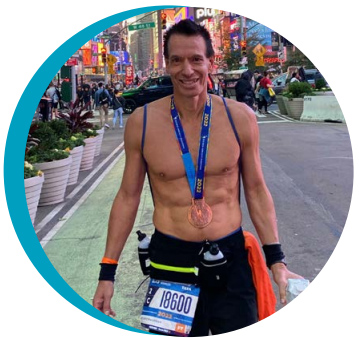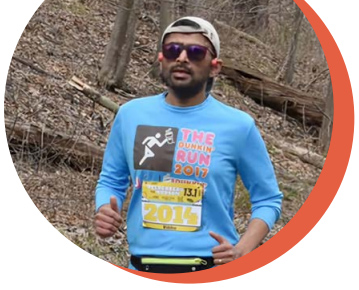Setting the Pace: Drexel Alums Go Fast and Far

For three alumni — Jack London, Glenn Stambo and Vibhu Sharma competitive races have become a way of life. And perhaps most inspiringly, all three say they have continue to improve their fitness well beyond the age of 40.


Jack London, 2008 Ironman race, Louisville, Kentucky
Elite Performance: JACK LONDON, MD, MCP ’92
A lifelong athlete and outdoor enthusiast, Jack London was a dedicated swimmer into their 20s — to the point of “sneaking back” on the Bryn Mawr College campus to use the pool on weekends well after graduation. Then, friends in medical school introduced them to running.
It was an exciting and fun way to fit exercise into the busy medical school lifestyle. They recall taking lunchtime runs with a group of colleagues around the hospital campus with their pagers on.
“It was easy: Just put your shoes on and go,” they say. London initially had an aspiration of being the next Hawkeye Pierce from M*A*S*H*, but trauma surgery and its high-adrenaline lifestyle was not the right fit for them, so they moved on to pediatrics. Now a general pediatrician with an interest in developmental pediatrics and sports medicine, London is based in Buffalo, New York.
Once a more casual hobby, running became a full-on passion in the late 1990s, when London started competing in 5K races, marathons and later triathlons. “It turned out that I was not slow. So then I started working toward half marathons and marathons until I qualified for Boston.”
That was the first of six times London has competed in the Boston Marathon — and they’ve racked up 30 total marathons across the country. Then it was onto the next big challenge.
“My very first Ironman was on my 41st birthday in 2007, and I did it with a broken tailbone because I had crashed my bike three weeks before the race. I actually had to get my bike repaired, and it turned out it wasn’t quite ready for prime time. That mechanical problem lost me a lot of time and cost me a lot of energy. But it was still a great day. It rained right up until the beginning of the swim start, and then the rain stopped, and then you got to swim and it was perfect. When I finished the bike component and the handlers took my bike, they asked how I felt. I said ’Great. All I have to do is run a marathon and I’m done.’ I was serious but they sort of stared at me.”
For London, participating in races over the years has been a social outlet, meeting friends new and old along the way and training with them between events. Racing has also been a meaningful way to embrace their identity as a nonbinary person. While most races up until very recently required them to register as a woman, a newer nonbinary category will now allow London to enter and compete in a gender-affirming environment.
“It is going to be very interesting to see how organizations run that division — different races are going to do things differently, and that’s fine. But I’m looking forward to seeing where it goes, because it’s a really cool and important first step in making everybody feel like they belong in the community. Change takes a long time. You know, it’s not that hard to change what kind of shirt somebody gets or to ask what their preferred name is or to ask what their preferred pronouns are. Or to have your bib have the name you want it to have. But this was never the case until now.”
London has won many medals over the years and has also qualified several times for the USA Triathlon Age Group nationals, but only competed once due to scheduling conflicts. Now in their mid-50s, they last completed an Ironman in 2016, Since then, they have participated in very long-distance races such as 50K trail runs and six-hour runs. They are now training for long-distance open water events. The goal, always, is to work as hard as possible, keep progressing and perform well in their age group.
Training and competing in individual sports is a meditative act for London, and it has given them a way to build confidence that transcends the race course.
“Running and biking alone, you have to be comfortable in your own head. That makes you comfortable with who you are, which is good for medicine, for sports and everything in life. It has made me a better person. It has in many ways defined who I am today, and I am grateful for it.”

Glenn Stambo, 2022 New York City Marathon
Faster Than Ever: GLENN STAMBO, MD, HU ’91
Glenn Stambo didn’t envision himself as a triathlon competitor back in the late 1980s and early 1990s when he first started running the streets of Philly on his study breaks in medical school. Back then, it was a way to kickstart a healthier lifestyle.
“I saw the light that we need to stay healthy in this business, in medicine. And I picked up running and it was almost like the best bang for your buck. You know, we only have a short amount of free time in the medical field, so we have to maximize it.” The bonus knock-on effect, he says, is that an athletic mindset helped him to buffer the trials and challenges of residency and fellowship, and build the foundation of a more balanced life today.
After finishing up his degree at Hahnemann, Stambo went on to a radiology residency at Hartford Hospital and then a fellowship in interventional radiology at the University of Massachusetts. Since then, he’s been in private practice and also academia, serving as an interventional radiology professor at Boston University. For the past 20 years he’s lived in Tampa, Florida, where he has a private practice in interventional and diagnostic radiology.
It wasn’t until Stambo graduated from medical school and started working in earnest that he began to train for road races. He’s steadily built up his distance and endurance over the years and raised his goals accordingly. Today, his “track” record includes more than 50 distance races, 25 half-marathons (three of which he ran with his wife) and numerous triathlons. In 2009, he ran the Marine Corps marathon on behalf of his father, who served as a Marine. Most recently, he completed the New York City Marathon in November 2022.
Stambo maintains a rigorous running schedule wherever possible, but it’s more about frequency than time spent in each session. “The best you can hope to get after working and without getting phone calls, is maybe 4 miles in a run. I might do that every couple days and then maybe a longer run on the weekend, say, 6 to 7 miles. The key is cross training. I do bicycling and swimming.”
He somewhat ramps up this routine when training for a marathon or triathlon, but he finds that his consistency over the years has paid off to the point where he doesn’t need a more traditional approach to distance training or any formal coaching to prepare. The results, he says, have demonstrated the success of this approach. “I’m up there winning races in my age group. It’s really hard to believe sometimes,” he says. “Looking back, my 30s were tougher because I was just learning how to race, and so I kind of held back and wasn’t as fast as I could have been. But now, since I hit my 40s and beyond, I feel like I’m just taking off and doing much better. Even better than some of the 30 and 40-yearolds. I am also very lucky that I don’t have any joint problems.”
Now the father to a son and a daughter, who are athletic in their own right, Stambo vigilantly maintains a healthy lifestyle, eating carefully and relying on natural remedies where possible. He not only feels focused and energetic, but he says he is as mentally sharp as ever.
“There’s no question that this was the right path for me, and I think anyone can benefit from it.”

Vibhu Sharma, 2022 Helderberg Hudson Half Marathon
Going the Distance: VIBHAVASU VIBHU SHARMA, MD; GERIATRIC MEDICINE FELLOWSHIP, DREXEL/HU ’04
Unlike many avid runners, Vibhu Sharma did not take up the habit in his teens or 20s. In fact, he only started running five years ago, in his early 40s. But he has made up for lost time, gradually building up his distance and endurance to participate in marathons.
“I was not at the typical age that most people start, and I would not call myself a master runner, but I very much enjoy the activity and reap all of its benefits by doing it regularly,” he says.
Sharma got his medical degree from University of Delhi in India. Following his internal medicine residency at Easton Hospital, an affiliate of Drexel, Sharma completed a one-year geriatrics fellowship at Drexel. He then went on to an endocrinology fellowship at University of Massachusetts and now works in the endocrinology practice of Albany Medical Center and as an associate professor of medicine at Albany Medical College.
He was well into his career when a friend invited him to a 5K charity run. Sharma found the experience both fun and challenging. He registered for a few more 5Ks in the ensuing months, then began training for longer distances, including his first half marathon in 2019. “Then, with the pandemic, things kind of slowed down. There were not many races for two years, but I took that time to gradually build myself up and aim higher. I did my first marathon, the Upstate Classic, here in Albany, in November last year. It was a great experience — not the easiest, but I was able to finish in the time I was hoping for.”
Given the constraints of his professional life and other commitments, Sharma hopes to run marathons every other year going forward, with his next one slated for 2024. The plan is to come back to his Drexel turf for the Philadelphia Marathon. He currently trains three to four times a week, both alone and occasionally with a running group, which he says includes many local health care workers. Sometimes he runs with his older son, who competes with his high school cross-country team. Above all, Sharma doesn’t get too caught up in times or rankings. Health and wellness are the ultimate goal.
Looking back, he enjoys his accomplishments and takes pride in how far he’s come. “Just finishing a half-marathon or a marathon is a hard goal to achieve and it keeps you focused and active, which is more important to me than any specific race goals. That, and staying injury-free.” Still, he says, the experience has been transformative. “You don’t know if you even have the ability to run that kind of a distance at first, and I really doubted myself in the beginning as to whether it was feasible. But, you know, gradually, you realize that your body is capable of doing more. It just has to be a little bit structured in how you approach this, and you have to have some goals in place. The rest should hopefully follow.”
Back to Top